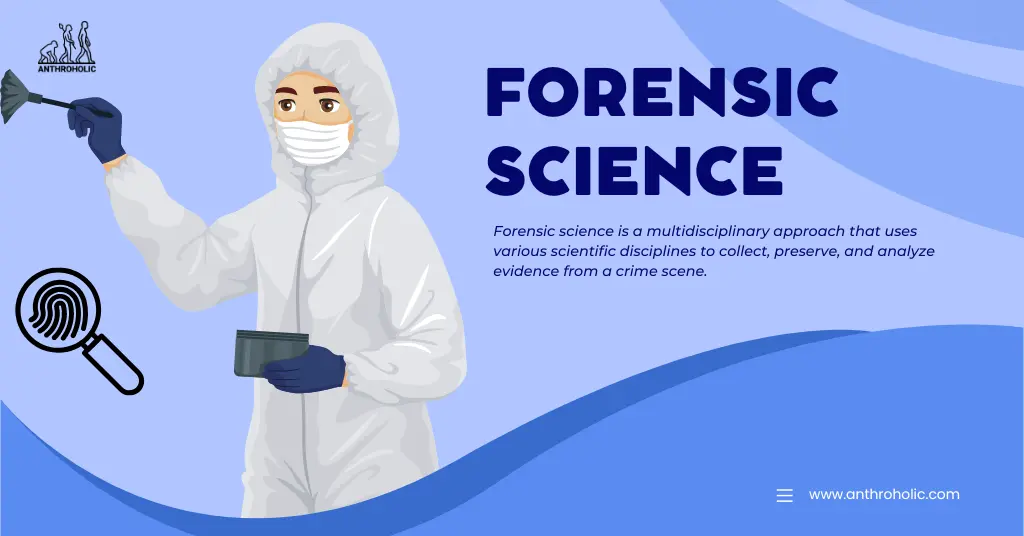AI Answer Evaluation Platform Live Now. Try Free Answer Evaluation Now
Forensic Science
Forensic Science lies at the crossroads of the legal and scientific worlds, deploying scientific methods to aid in the investigation of crime. It provides unbiased scientific evidence for use in courts of law to solve crime puzzles [1]. This article delves into the world of forensic science, its various branches, importance, and how it shapes the future of criminal justice.

Understanding Forensic Science
Forensic science is a multidisciplinary approach that uses various scientific disciplines to collect, preserve, and analyze evidence from a crime scene [2]. It includes disciplines such as:
- Forensic Pathology
- Forensic Anthropology
- Forensic Psychology
- Forensic Odontology
- Forensic Entomology
Table 1 provides a snapshot of these fields:
Table 1: Branches of Forensic Science
| Branch | Description |
|---|---|
| Forensic Pathology | Investigation of cause of death [3] |
| Forensic Anthropology | Identification of individuals using skeletal remains [4] |
| Forensic Psychology | Understanding the minds of criminals [5] |
| Forensic Odontology | Identification through dental records [6] |
| Forensic Entomology | Using insect activity in criminal investigations [7] |
The Role and Importance of Forensic Science
Unbiased Evidence
Forensic science provides unbiased, accurate, and reliable evidence, making it a crucial component of the justice system. It helps in both the exoneration of the innocent and the conviction of the guilty based on physical evidence rather than conjecture or unreliable witness accounts [8].
Crime Scene Reconstruction
Forensic scientists use their expertise to reconstruct crime scenes. They can determine the sequence of events, identify the weapon used, and sometimes even discern the perpetrator’s intent [9].
Identification
Forensic science can also aid in identifying victims or perpetrators. Through fingerprint analysis, DNA profiling, and dental records, forensic scientists can establish identities even in cases where standard identification methods are not applicable [10].
The Future of Forensic Science
The future of forensic science is exciting, with innovations poised to bring about a revolution in crime-solving. Key areas of innovation include:
- Genomics: Advanced DNA analysis techniques and the potential of gene editing are opening new possibilities for forensic science [11].
- Digital Forensics: With the rise of cybercrime, digital forensics has become increasingly important. Techniques for tracing digital footprints and understanding complex cybercrimes are being developed [12].
- Artificial Intelligence (AI): AI can help analyze vast amounts of data quickly and accurately, enabling faster and more precise investigations [13].
Real-Life Application of Forensic Science
Forensic science is an integral part of many real-life investigations and court proceedings. It has been used in several high-profile cases, such as the O.J. Simpson trial and the solving of the Green River Killer case. In both instances, forensic evidence played a significant role in the investigation’s direction and resolution [14].
Criminal Investigation
In criminal investigations, forensic evidence is often the key to solving the case. Forensic scientists use their expertise to analyze physical evidence and contribute to building a solid case against the suspect. From fingerprints and blood spatter to trace evidence like hair and fibers, forensic science offers various tools for investigators to exploit [15].
Courtroom Evidence
In the courtroom, forensic evidence serves as a critical element in convincing the jury of the accused’s guilt or innocence. In several instances, it’s the forensic evidence that holds the highest sway, often considered more reliable than eyewitness accounts, which can be influenced by various factors [16].
The Ethical Aspect of Forensic Science
While forensic science offers immense advantages, it also brings forth several ethical issues. These include but are not limited to:
- Privacy Concerns: The extensive use of DNA profiling and other such forensic tools can lead to significant privacy concerns, especially regarding genetic information and digital data [17].
- Use of Forensic Databases: Databases storing sensitive information, like DNA or fingerprint profiles, can be prone to misuse if not properly regulated [18].
- Quality Control and Assurance: There can be significant variance in the quality of forensic analysis. Erroneous interpretations or laboratory mistakes can lead to miscarriages of justice [19].
Conclusion
Forensic science is an indispensable tool in modern law enforcement, providing the solid bridge between science and law. Its expanding disciplines and rapidly advancing technology promise to revolutionize crime-solving methods and the justice system. As our understanding of both science and crime deepens, forensic science will continue to play an increasingly important role in shaping the future of criminal justice.
References
[1] James, S. H., & Nordby, J. J. (2013). Forensic Science. Academic Press.
[2] Houck, M. (2015). Forensic Science: A Multidisciplinary Approach. Wiley.
[3] Di Maio, V. J. (2001). Forensic Pathology, Second Edition. CRC Press.
[4] Dirkmaat, D. C. (2012). A Companion to Forensic Anthropology. Wiley-Blackwell.
[5] Rosen, J. (2013). Law Disorder: The Psychology of Crime. Cambridge University Press.
[6] Pretty, I. A., & Sweet, D. (2010). A look at forensic dentistry—Part 1: The role of teeth in the determination of human identity. British Dental Journal.
[7] Byrd, J. H., & Castner, J. L. (2010). Forensic Entomology: The Utility of Arthropods in Legal Investigations. CRC Press.
[8] Inman, K., & Rudin, N. (2001). Principles and Practice of Criminalistics: The Profession of Forensic Science. CRC Press.
[9] Eckert, W. G. (1997). Introduction to Forensic Sciences. CRC Press.
[10] Butler, J. M. (2005). Forensic DNA Typing: Biology, Technology, and Genetics of STR Markers. Academic Press.
[11] Kayser, M. (2015). Forensic DNA Phenotyping: Predicting human appearance from crime scene material for investigative purposes. Forensic Science International: Genetics.
[12] Casey, E. (2011). Digital Evidence and Computer Crime: Forensic Science, Computers and the Internet. Academic Press.
[13] Richards, R. (2019). Artificial Intelligence in Policing: Benefits and Challenges. Policing: A Journal of Policy and Practice.
[14] Lange, D. (1997). The Role of Forensic Science in the O.J. Simpson Trial. California Western Law Review.
[15] Eckert, W. G. (1997). Introduction to Forensic Sciences. CRC Press.
[16] Haag, L. C. (2006). Shooting Incident Reconstruction. Academic Press.
[17] Suter, S. M. (2004). The Allure and Peril of Genetics Exceptionalism: Do We Need Special Genetics Legislation? Washington University Law Review.
[18] Kaye, D. H. (2010). The Double Helix and the Law of Evidence. Harvard University Press.
[19] Giannelli, P. C. (2007). Wrongful Convictions and Forensic Science: The Need to Regulate Crime Labs. North Carolina Law Review.




